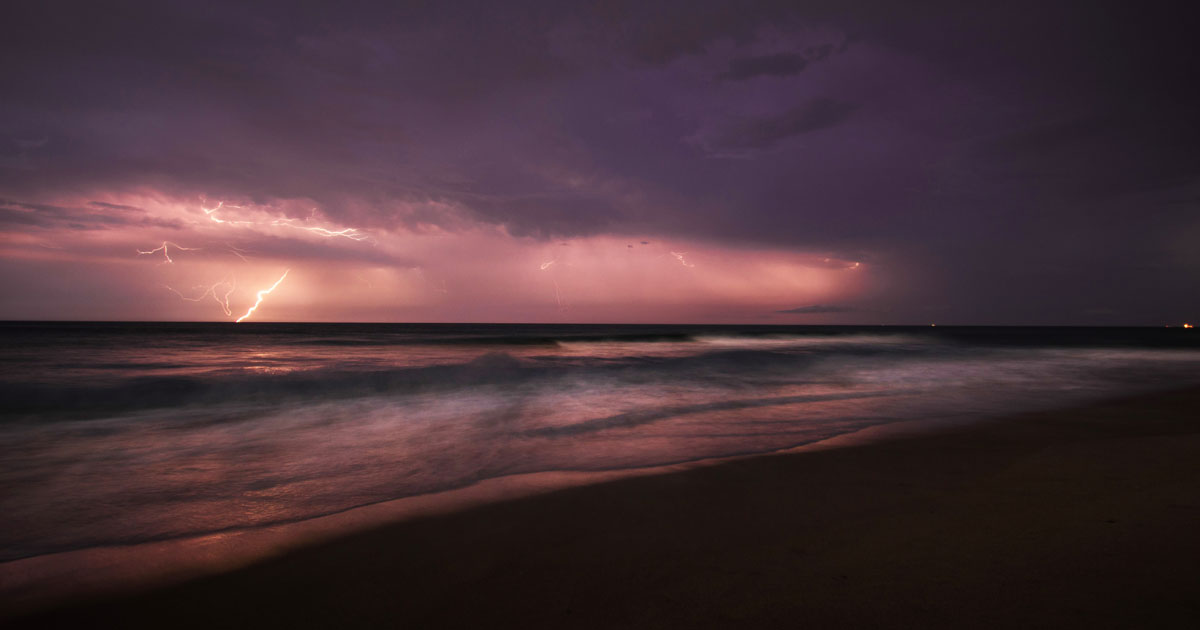Here's Your Primer to Keep It from Happening to You.
Summer days lure many people to the water, but water is one of the most dangerous places to be if a storm strikes.
Typing on your computer, talking on a landline phone or taking a shower put you into the danger zone, too. Did you know you have a higher risk of getting struck by lightning than you do of striking it big in the lotto? How do 1 in 15,000 odds strike you?
A lot of people are surprised by this, noted Amy Spencer, MD, medical director of the Spectrum Health Regional Burn Center.
Every year lightning kills dozens of people in the United States. According to the National Weather Service, about 10% of people struck by lightning die, leaving 90% with varying degrees of injury and disability.
Michigan ranks among the top states in the nation for lightning injuries and deaths, and much of that is attributed to outdoor activities such as fishing, camping, boating and swimming. While the summertime months are the most dangerous in terms of lightning strikes and injuries, July is usually the worst month.
Here are some quick hits you need to know before lightning strikes.
Know the Risk Factors.
"The No. 1 spot for people to get struck is while they are fishing out on the water, followed by camping and boating," Dr. Spencer said.
The majority of fatal strikes claim the lives of men and boys.
"They think it's because they don't leave the area to find shelter," she said.
Soccer fields and golf courses are other high-strike areas, because those activities are so popular.
Strikes can also travel through wiring and plumbing so stay away from your computer, landline phone, electric appliances, shower, bathtub and toilet during storms. It is safe to use a cell phone.
Take Cover Immediately.
If you see lightning, don't stick around for the sky show. Take cover immediately.
"There are no safe places anywhere outside," Dr. Spencer said. "As soon as you hear thunder, you have to assume lightning is nearby. Most lightning is within 10 miles of audible thunder. Lightning can strike anyone outside."
Get inside a vehicle or sturdy structure, preferably not a concrete building.
"The plumbing and wiring that runs down the walls can conduct electricity," she said. "If a concrete building is the only structure around, it's safer than being outdoors. Just stay away from the walls."
Do not take shelter under trees. They are frequently struck by lightning and can cause side strikes to nearby humans. Tree strikes can also cause a ground current strong enough to kill up to 66 feet from the tree.
Convertibles with rag tops aren't safe, either. If you drive one, stop and take cover in the nearest sturdy building.
How Far Away Is It?
If you hear thunder, there is lightning.
"Thunder is caused by lightning," Dr. Spencer said. "When lightning goes through the air, it heats the air and makes the air expand. It contracts as it cools. As the air expands and contracts, it causes a thunder clap."
The thunder starts at the site of the lightning and travels about one mile every five seconds. If you see lightning, start counting, in seconds, until you hear thunder.
If, for example, you count off 10 seconds between lightning and thunder, divide the 10 seconds by five. That tells you the lightning is two miles away.
You can't hear thunder if it's more than 10 miles away so when people say they see heat lightning, it's really a misnomer, according to Dr. Spencer.
"It actually means that the lightning is farther away than you can hear the thunder," she said. "It's actually real lightning. It's just farther away."
The Physiology of a Lightning Strike.
If you get struck by lightning, chances are your heart won't handle it.
"If you have a direct lightning strike, you have a high chance of suffering cardiac arrest," Dr. Spencer said. "Because lightning is electric, it interrupts and disrupts your cardiac and neurological systems. The most common cause of death in a lightning strike is cardiac arrest."
If you do survive a strike, you're likely to suffer from headaches, body pain, fatigue, difficulty sleeping, short-term memory loss and personality changes.
"It really messes with your neurological system," she said. "You can also get burns from a lightning strike, at the entrance and exit sites."
But those burns may go deeper than the eye can see.
"With burns from electricity or lightning there's often deep tissue injury because that's where the heat is dissipating," she said. "Sometimes the burn is more extensive deeper down than what you see on the surface."
Lightning is More Powerful Than Electricity.
Normal household current is 120 volts, or 15 amps.
Lightning carries 300 million volts, or 30,000 amps of electricity, she said.
"There's electrical charge in the storm clouds," Dr. Spencer said. "It builds up because the clouds themselves are not very good with conduction."
When the electricity becomes too much, it shoots downward as lightning.
Dr. Spencer said the power surge is mind-boggling.
"I've seen a lot of electrocution from power lines, but I've never seen a lightning strike," she said. "The amount of electricity from lightning is much higher than what comes through household electrical lines or even power lines."
If You or Someone You're With Has Been Hit ...
"If you come across someone who has been struck, and they are unresponsive with no pulse, they are not conducting electricity themselves," Dr. Spencer said. "You will not suffer electrical shock from touching them. They need CPR, and an AED if possible, to try to restart the heart."
If you or someone else has been struck, even if you don't see any outward damage, seek medical attention immediately. There could be heart, neurological or deep tissue damage invisible to the eye.
Lightning Can Strike Twice.
"If you have been hit, and you're awake and conscious, remove yourself from the area," Dr. Spencer said. "If there's lightning that struck you, there's the possibility of further lightning. Lightning can strike twice. I don't think you'd survive the second strike if you survived the first."
If you've been hit?
"You should get to a safe area and get medical attention to make sure your heart is functioning normally and you don't have any burns or other injuries that need to be taken care of," she said.
Lightning Doesn't Always Pick the Highest Point.
Don't believe if you're standing next to something, or someone, taller than you, that you're safe.
Lightning doesn't discriminate that way, according to Dr. Spencer.
Fascinating lightning facts (from NOAA):
- About 10% of those struck by lightning die.
- Lightning kills an average 43 people in the United States every year.
- There are about 8 million lightning strikes around the world each day.
- Lightning causes more than $900 million in damage each year in the U.S.
- Lightning ignites about 12% of all forest fires.
- Lightning strikes the United States about 25 million times a year.
Written by Marie Havenga, Courtesy of Spectrum Health HealthBeat Blog.
This article was republished with permission and originally appeared at Spectrum Health HealthBeat Blog.




